
Oriental Garden Lizard Care: Tips for a Happy and Healthy Pet
Owning a pet lizard, particularly an Oriental Garden Lizard, can be a fascinating and rewarding experience. These beautiful reptiles, also known as the Eastern Garden Lizard or Calotes versicolor, are native to Southeast Asia and are popular among reptile enthusiasts. If you’re planning to bring home an Oriental Garden Lizard, here are some essential care tips to ensure your pet thrives in its new environment.
1. Enclosure Setup
Creating a suitable enclosure is crucial for your Oriental Garden Lizard’s well-being. Start by selecting a spacious terrarium or vivarium that mimics its natural habitat. A 20-gallon tank should suffice for a single adult lizard. Provide ample climbing opportunities using branches, rocks, and other reptile-safe decorations. Ensure the enclosure has a secure lid to prevent escape.
2. Temperature and Lighting
Maintaining optimal temperature and lighting conditions is vital for the health and happiness of your Oriental Garden Lizard. Use a combination of heat lamps and UVB bulbs to create a temperature gradient within the enclosure. The basking spot should be around 95°F (35°C), while the cooler side should range between 80-85°F (27-29°C). UVB lighting aids in calcium metabolism and prevents metabolic bone disease.
3. Humidity and Hydration
Oriental Garden Lizards require moderate humidity levels to thrive. Aim for a humidity range of 50-60% inside the enclosure. Misting the enclosure with clean water or using a reptile fogger can help maintain humidity levels. Provide a shallow water dish for your pet to drink from and soak in. Regularly clean and refill the water dish to ensure cleanliness.
4. Feeding and Diet
A proper diet plays a crucial role in maintaining your Oriental Garden Lizard’s health. These lizards are omnivorous, so their diet should include a variety of live insects such as crickets, mealworms, and roaches. Additionally, feed your pet a mix of leafy greens, fruits, and occasional small vertebrates like pinky mice. Ensure that the prey items are of appropriate size and adequately dusted with reptile calcium and vitamin supplements.
5. Handling and Interaction
While Oriental Garden Lizards may tolerate occasional handling, they are primarily an observation pet. Give your lizard time to acclimate to its new environment before attempting to handle it. Always approach your pet calmly and avoid sudden movements that may startle it. If you do handle your lizard, support its body properly and avoid gripping its tail, as they can drop their tail as a defense mechanism.
6. Regular Veterinary Care
To ensure the long-term well-being of your pet lizard, schedule regular check-ups with a qualified reptile veterinarian. These professionals can provide valuable advice on diet, habitat, and overall care. Additionally, they can address any potential health concerns and offer necessary treatments or vaccinations.
Remember, owning an Oriental Garden Lizard is a long-term commitment. By providing a well-designed enclosure, a nutritious diet, and proper care, you can enjoy the companionship of a happy and healthy lizard for many years to come.
Keep Reading

Bearded Dragon Hatchling Care: A Complete Guide
Taking care of a bearded dragon hatchling can be an incredibly rewarding experience. These tiny and adorable reptiles require special attention and care as they are delicate and vulnerable.

Knob-Tailed Gecko Care: Essential Tips for Lizard Owners
Looking to become a proud owner of a knob-tailed gecko? Look no further! In this comprehensive guide, we'll walk you through the essential care tips to ensure your pet lizard's health and happiness.